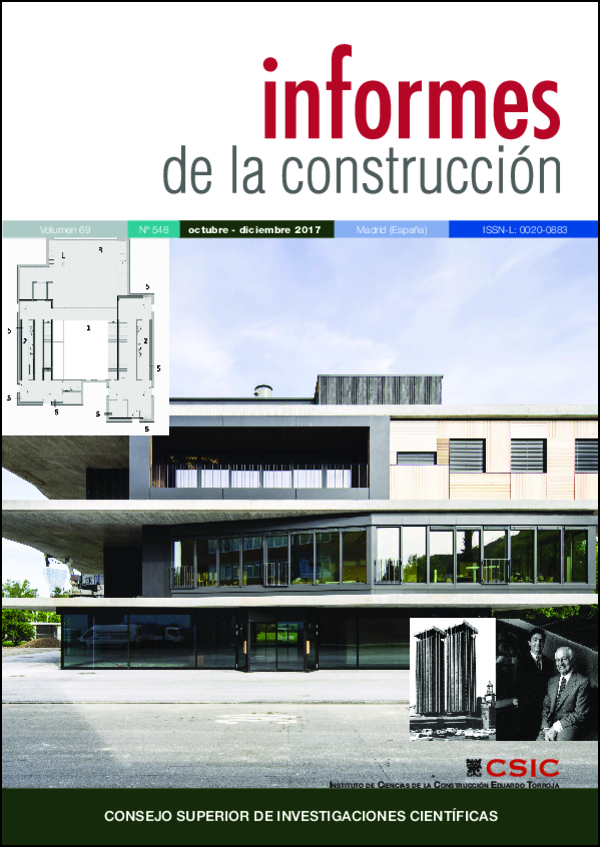Monumental rammed earth conservation: past, present and future
DOI:
https://doi.org/10.3989/ic.16.160Keywords:
restoration, earthen architecture, rammed earth, criteriaAbstract
The growing interest in the study of earthen architecture developed in Europe in the late 1970s reached Spain at a later stage. As the interest in these historical earthen architecture structures grew, so did the number of restoration projects for monumental buildings originally constructed using the technique of rammed earth. As the interventions on earthen architecture in the Iberian Peninsula increased in the 1980s, these restorations are now relatively old. This research aims to have an overview the interventions carried out on rammed earth monumental buildings in Spain using national funds, through a global analysis of the most frequent pathologies found in these structures, the criteria adopted, the constructive techniques used, as well as the results obtained.
Downloads
References
(1) AA.VV. (2011). Terra Europae: earthen architecture in the European Union. Pisa: ETS.
(2) Correia, M. (2007). Teoría de la conservación y su aplicación al patrimonio en tierra. En Apuntes nº 20. Bogotá: Pontificia Universidad Javeriana.
(3) Mileto, C. & Vegas, F. (Ed). (2014). La restauración de la tapia en la Península Ibérica. Criterios, técnicas, resultados y perspectivas. Valencia / Lisboa: TC Cuadernos / Argumentum. PMCid:PMC5528623
(4) Mileto, C.; Vegas F.; Cristini, V.; García Soriano, L. (2012). Sanierung historicher Stampflehmbau-Konstruktionen auf der Iberichen Halbinsel – Kriterien, Techniken, Ergebnisse und Perspektiven / The restoration of rammed earth architecture in the Iberian Peninsula – criteria, techniques, results and perspectives. En Reinserberger J., Jörchel S. (Ed), LEHM 2012. Tagungsbeiträge del 6 Internationalen Fachtagung für Lahm-bau. Weimar: Dachverband Lehm.
(5) Carbonara, G. (1997). Avvicinamento al restauro, p. 451-510. Napoles: Liguori.
(6) Jokilehto, J. (1999). A History of Architectural Conservation, p. 295-304. Londres-New York: Elsevier.
(7) Earl, J. (2003). Building Conservation Philosophy, pp. 80-118. Dorset: Donhead.
(8) Doglioni, F. (2008). Nel restauro. Progetti per le architetture del passato, p. 85-103. Venecia: Marsilio. PMCid:PMC2271025
(9) García Soriano, L. (2015). La restauración de la arquitectura de tapia de 1980 a la actualidad a través de los fondos del Ministerio de Cultura y del Ministerio de Fomento del Gobierno de España. Criterios, técnicas y resultados (Tesis doctoral no publicada). Valencia: Universitat Politècnica de València. PMid:25748645
(10) AA.VV. (2007). Proyecto de restauración del castillo de La Mola. 2ª Fase. En Praxis edilicia. 10 Años con el Patrimonio Arquitectónico, p. 200-205. Valencia: Ediciones Generales de la Construcción.
(11) Olivier, M. (1993). Restauration des estructures en terre crue en fonction de leur technologie de construction. En Conservation of Stone and other materials, vol. 2. Prevention and treatments, p. 673-680. Paris.
(12) Guarner, I. (1987). Restauración de la muralla de Niebla, Huelva. En Monografía nº385/386. Madrid: Inst. Eduardo Torroja. PMCid:PMC1433928
(13) Maldonado Ramos, L., Castilla Pascual, F. J. & Vela Cossío, F. (1997). La técnica del tapial en la comunidad autónoma de Madrid: Aplicación de nuevos materiales para la consolidación de muros de tapia. Informes de la Construcción, 49(452): 27-38. https://doi.org/10.3989/ic.1997.v49.i452.925
(14) Monjo, J. (1998). La tierra como material de construcción. Patología y técnicas de conservación. Tratado de Rehabilitación. Tomo II: Estructuras. Madrid: Ed. Munilla-Lería. PMid:9557363
(15) López Osorio, J. M. Restauración de la Torre de los Secretos. Castillo de Baena (Córdoba). En Loggia 24-25. Valencia: Editorial UPV.
(16) Guillaud, H. (1985). Quelques recommandations pour l’entretien et la restauration du pisé. Texto Inédito. Grenoble. École d’Architecture de Grenoble, CRAterre.
(17) Hunt, R. & Suhr, M. (2008). Old house Handbook. A practical guide to care and repair. London: ed. Frances Lincoln Limited.
(18) AA.VV. (2008). Terra Incognita. Découbrir e preserver une Europe des Architectures de tierre. Bruselas / Lisboa: Culture Lab Editions / Argumentum.
(19) Pignal, B. (2005). Terre crue: Techniques de construction et de restauration. Paris: Eyrolles.
(20) Bollini, G. (2013). Terra battuta: técnica construttiva e recupero. Linee guida per le procedure d’intervento. Milan: Edicom Edizioni.
(21) Scarato, P. (1986). Pathologie et réhabilitation du patrimoine en pisé. Modernité de la construction en terre, p. 251-262. Paris.
Published
How to Cite
Issue
Section
License
Copyright (c) 2018 Consejo Superior de Investigaciones Científicas (CSIC)

This work is licensed under a Creative Commons Attribution 4.0 International License.
© CSIC. Manuscripts published in both the print and online versions of this journal are the property of the Consejo Superior de Investigaciones Científicas, and quoting this source is a requirement for any partial or full reproduction.
All contents of this electronic edition, except where otherwise noted, are distributed under a Creative Commons Attribution 4.0 International (CC BY 4.0) licence. You may read the basic information and the legal text of the licence. The indication of the CC BY 4.0 licence must be expressly stated in this way when necessary.
Self-archiving in repositories, personal webpages or similar, of any version other than the final version of the work produced by the publisher, is not allowed.















